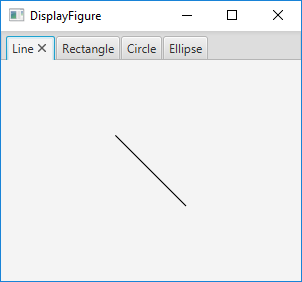

TabPaneDemo.javaimport javafx.application.Application;
import javafx.scene.Scene;
import javafx.scene.control.Tab;
import javafx.scene.control.TabPane;
import javafx.scene.layout.StackPane;
import javafx.scene.shape.Circle;
import javafx.scene.shape.Ellipse;
import javafx.scene.shape.Line;
import javafx.scene.shape.Rectangle;
import javafx.stage.Stage;
public class TabPaneDemo extends Application {
@Override // Override the start method in the Application class
public void start(Stage primaryStage) {
TabPane tabPane = new TabPane();
Tab tab1 = new Tab("Line");
StackPane pane1 = new StackPane();
pane1.getChildren().add(new Line(10, 10, 80, 80));
tab1.setContent(pane1);
Tab tab2 = new Tab("Rectangle");
tab2.setContent(new Rectangle(10, 10, 200, 200));
Tab tab3 = new Tab("Circle");
tab3.setContent(new Circle(50, 50, 20));
Tab tab4 = new Tab("Ellipse");
tab4.setContent(new Ellipse(10, 10, 100, 80));
tabPane.getTabs().addAll(tab1, tab2, tab3, tab4);
Scene scene = new Scene(tabPane, 300, 250);
primaryStage.setTitle("DisplayFigure"); // Set the window title
primaryStage.setScene(scene); // Place the scene in the window
primaryStage.show(); // Display the window
}
/**
* The main method is only needed for the IDE with limited
* JavaFX support. Not needed for running from the command line.
* line.
*/
public static void main(String[] args) {
launch(args);
}
}
Maintained by John Loomis, updated Sun Mar 11 16:07:48 2018